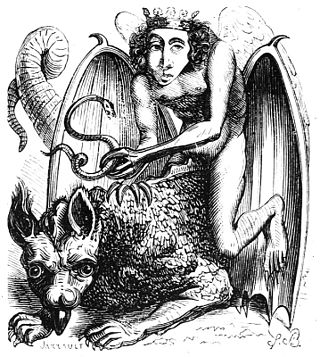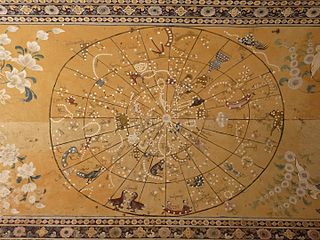
Ultima is a series of open world fantasy role-playing video games from Origin Systems, created by Richard Garriott. Electronic Arts has owned the brand since 1992. The series had sold over 2 million copies by 1997.
Hindu astrology, also called Indian astrology, jyotisha and, more recently, Vedic astrology, is the traditional Hindu system of astrology. It is one of the six auxiliary disciplines in Hinduism that is connected with the study of the Vedas.

Astaroth, in demonology, is known to be the Great Duke of Hell in the first hierarchy with Beelzebub and Lucifer; he is part of the evil trinity. He is known to be a male figure, most likely named after the unrelated Near Eastern goddess Astarte.

Aamon, in demonology, is a Grand Marquis of Hell who governs 40 infernal legions, and the 7th spirit of the Goetia. He is the demon of life and reproduction.
In demonology, Morax, also spelled Foraii, Marax, or Farax, is a Demon, Great Earl, and President of Hell, having thirty legions of demons under his command. He teaches astronomy and all other liberal sciences, and gives good and wise familiars that know the virtues of all herbs and precious stones.

The demon Naberius was first mentioned by Johann Weyer in 1583. He is supposedly the most valiant Marquess of Hell, and has nineteen legions of demons under his command. He makes men cunning in all arts, but especially in rhetoric, speaking with a hoarse voice. He also restores lost dignities and honors, although to Johann Weyer, he procures the loss of them.

In demonology, Ronove is a Marquis and Great Earl of Hell, commanding twenty legions of demons. He teaches art, rhetoric, languages, and gives good and loyal servants the favour of friends and foes.
In demonology, Forneus is a Great Marquis of Hell, and has twenty-nine legions of demons under his rule. He teaches Rhetoric and languages, gives men a good name, and makes them be loved by their friends and foes.
Foras or Forrasis, in demonology, is a powerful president of Hell, being obeyed by twenty-nine legions of demons. He teaches logic and ethics in all their branches, the virtues of all herbs and precious stones, can make a man witty, eloquent, invisible, and live long, and can discover treasures and recover lost things.

In demonology, Marchosias is a great and mighty Marquis of Hell, commanding thirty legions of demons. In the Ars Goetia, the first book of The Lesser Key of Solomon, he is depicted as a wolf with griffin wings and a serpent's tail, spewing fire from his mouth. At the request of the magician, he may take the form of a man. He is a strong fighter, gives true answers to all questions, and is very faithful to the magician in following his commands. Before his fall, he belonged to the angelic order of Dominations, and when he was bound by Solomon, he told him that after 1,200 years, he hoped to return to Heaven.
In demonology, Phenex is a Goetic demon. A Great Marquis of Hell he has twenty legions of demons under his command. He teaches all wonderful sciences, is an excellent poet, and is very obedient to the conjuror. Phenex hopes to return to Heaven after 1,200 years.
In demonology, Raum is a Great Earl of Hell, ruling thirty legions of demons. He is depicted as a crow which adopts human form at the request of the conjurer.
"Raum, Reym (Rey) or Raim is a great earle, he is seene as a crowe, but when he putteth on humane shape, at the commandement of the exorcist, he stealeth woonderfullie out of the kings house, and carrieth it whether he is assigned, he destroieth cities, and hath great despite unto dignities, he knoweth things present, past, and to come, and reconcileth freends and foes, he was of the order of thrones, and governeth thirtie legions."

Respect, also called esteem, is a positive feeling or deferential action shown towards someone or something considered important or held in high esteem or regard. It conveys a sense of admiration for good or valuable qualities. It is also the process of honoring someone by exhibiting care, concern, or consideration for their needs or feelings.

Demon: The Fallen is a 2002 tabletop role-playing game released by White Wolf Publishing. Set in the World of Darkness, players take on the role of a demon - a fallen angel who descended to the Garden of Eden with Lucifer, only to be condemned to Hell after a long war with Heaven. The game focuses on "infernal glory" as its central theme for storytelling and character development - the acquisition of power to restore the Fallen's grace as well as to potentially reconnect with humanity, all the while staving off their own agony and evading monstrous demons.

Hēidì or Hēishén, who is the Běidì or Běiyuèdàdì, is a deity in Chinese religion, one of the cosmological "Five Forms of the Highest Deity". He is also identified as Zhuānxū (颛顼), today frequently worshipped as Xuánwǔ or Zhēnwǔ (真武), and is associated with the essence of water and winter. His animal form is the Black Dragon and his stellar animal is the tortoise-snake. By virtue of his association with the north, he has been identified and revered frequently as a representation of the supreme God of Heaven.

Ketu is the descending lunar node in Vedic, or Hindu astrology. Personified as a deity, Rahu and Ketu are considered to be the two halves of the immortal asura (demon) Svarbhanu, who was beheaded by the god Vishnu.

Afterlife is a god game released by LucasArts in June 1996 that places the player in the role of a semi-omnipotent being known as a Demiurge, with the job of creating a functional Heaven and Hell to reward or punish the citizens of the local planet. The player does not assign citizens to their various punishments and rewards since the game does this automatically. Instead, the player creates the infrastructure that allows the afterlife to function properly. Players are accountable for the job that they do because of their bosses, The Powers That Be, check in from time to time. The player also has the assistance of two advisors—Aria Goodhalo, an angel, and Jasper Wormsworth, a demon. Aria and Jasper provide warnings when things are going wrong with the afterlife, and offer tips on how to fix the problems.

The Burmese zodiac is the traditional Burmese system of astronomy and astrology. While it is still an important component of the Burmese calendar, today, the zodiac is closely identified with Burmese astrology, called Baydin (ဗေဒင်). Largely derived from Hindu astronomy and Vedic astrology, the Burmese zodiac consists of not only the same 12 signs of the Western zodiac but also 27 lunar mansions of the month and eight weekday signs.

The Book of Felicity is an illuminated manuscript made in the Ottoman Empire in 1582. Commissioned by Sultan Murad III, who ruled the empire from 1574 to 1595, its text was translated from Arabic and all its miniatures were apparently directed by the famous master Nakkaş Osman, who undoubtedly painted the opening series of images related to the signs of the zodiac. Osman, the head of the painters at the seraglio workshop from 1570 onwards, created a style renowned for its lifelike portraits that influenced other artists in Murad's court.












